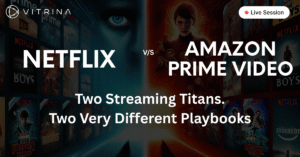Production House Collaboration in the Middle East: Tracking Partners

Introduction
The media and entertainment (M&E) industry’s pivot to the Middle East and North Africa (MENA) region is a strategic necessity, driven by ambitious state-backed investment and an insatiable regional demand for high-quality Arabic-language content.
For global studios, financiers, and distributors, finding reliable, specialized co-production partners is the core mission. However, traditional partner scouting models fail catastrophically in this market.
Mastering production house, collaboration, Middle East, tracking requires more than trade show attendance; it requires real-time, verified competitive intelligence to cut through the significant market opacity.
The ability to identify, vet, and contract a proven production house—verifying their track record and financial stability against the backdrop of rapid, unregulated growth—is the defining challenge for content acquisition and co-production deals today.
Table of content
- The New Strategic Imperative: Why Production House Collaboration in the Middle East Demands Tracking
- The MENA Paradox: High Investment, Opaque Vetting
- A Strategic Framework for Collaboration Tracking and Vetting
- Vitrina: The Single Source of Truth for Middle East Production House Intelligence
- Conclusion: Making Data-Driven Decisions in a High-Growth Market
- Frequently Asked Questions
Key Takeaways
| Core Challenge | Fragmented regional data and regulatory complexity make it nearly impossible to vet a Middle East production house’s true track record and operational status. |
| Strategic Solution | Employ an entity-centric data platform for real-time tracking of project status, executive contacts, and company-to-company collaboration history. |
| Vitrina’s Role | Vitrina provides the verified intelligence framework necessary for secure partner vetting and efficient deal-making in the MENA entertainment supply chain. |
The New Strategic Imperative: Why Production House Collaboration in the Middle East Demands Tracking
The MENA region production market is undergoing a structural shift. The dominance of state-funded media and traditional linear TV has been rapidly challenged by a flurry of international and regional OTT platforms—a change that has created massive opportunities for local production houses.
However, this high-stakes landscape creates immediate risk for international executives: how do you ensure your investment is placed with a reputable, capable, and financially stable partner?
The traditional method of identifying a production house is reactive, relying on past success stories or personal connections. The modern imperative requires proactive tracking of development pipelines and entity-level data to model risk before a handshake deal is made.
Without this granular, real-time intelligence, content financing executives risk misalignment with local regulatory frameworks, inefficient resource allocation, and, critically, choosing a partner whose track record is anecdotal rather than verified.
The entire strategy for content acquisition strategy in the region hinges on the effectiveness of this upstream intelligence.
The MENA Paradox: High Investment, Opaque Vetting
The core difficulty in production house collaboration across the Middle East stems from a unique confluence of rapid commercial growth and entrenched structural opacity. International companies face a triad of challenges that cannot be solved by simply subscribing to a traditional industry database.
The Regulatory & Bureaucratic Friction
The logistical and political environment in the MENA region introduces significant friction to the M&E supply chain. Unlike established European markets, the process of obtaining permits for filming, navigating media content standards, and ensuring full compliance can be complex, often requiring specialized local knowledge and connections.
As noted by the Knowledge at Wharton, bureaucratic hurdles and regional security issues have historically pushed major Hollywood studios to favor more “failsafe” locations like Morocco or Tunisia over the primary media hubs like Egypt.
This risk aversion creates inertia. Therefore, when selecting a Middle East production house, the due diligence must extend beyond their creative portfolio to their proven ability to navigate these specific, non-creative compliance challenges. A strong partner vetting solution must effectively track evidence of successful navigation of these local complexities.
The Data Black Hole: Content Acquisition Without Viewership Metrics
The success of any content acquisition strategy relies on a clear understanding of the market and audience demand. However, the Middle East content market is often cited as a “data black hole” for traditional audience metrics.
Digital platforms rarely release audience share or ratings data, which makes the valuation of content and the forecasting of genre success controversial and difficult.
This forces content buyers to rely on external indicators and the track record of the actual production company. Since data on viewership is often unobtainable, the verified data on the company itself—its co-production history, its executive leadership, its financial ties, and its output volume—becomes the most critical, reliable, and actionable data set for underwriting a deal.
The Challenge of Scale and Verified Track Records
The rise of the “originals” market has led to the proliferation of small, independent production house entities. While these companies often represent the creative engine of the next wave of Arabic content, their track records are frequently unverified, siloed, or simply anecdotal.
For a studio executive looking to commit millions to a co-production deal, relying on a resume passed at a market is unacceptable.
The strategic solution requires the ability to instantly check a company’s full collaboration history:
Who have they worked with?
How many projects completed development versus production?
Which distributors were attached?
This level of granular, entity-level intelligence is necessary to convert speculative growth into secure investment and establish entertainment supply chain efficiency.
A Strategic Framework for Collaboration Tracking and Vetting
To mitigate the MENA paradox, executives must replace anecdotal scouting with a three-phased, data-driven framework for production house collaboration and tracking.
Phase 1: Contextual Due Diligence
This phase focuses on minimizing regulatory and reputational risk. It begins by identifying companies within jurisdictions known for proactive media infrastructure investment, such as those driven by Saudi Arabia’s Vision 2030 or the UAE’s media council initiatives.
The essential task is to screen for any past disputes or non-compliance issues and to confirm that the key executives listed have verified, active roles in the projects attributed to the company. The goal is not creative assessment but foundational risk mitigation.
Phase 2: Entity-Level Verification
This is the most critical stage, where tracking moves from market trends to hard data about the potential partner. An executive must be able to pull a comprehensive profile of the production house that includes:
- Collaboration History: A verified list of co-production partners, financiers, and service vendors on past projects.
- Project Lifecycle Data: Proof that projects attributed to the company have successfully progressed from development/pre-production through post-production and distribution.
This focus on entity-level data provides a clear picture of the company’s operational capacity and stability, which is far more reliable than generic regional statistics. For guidance on how to secure your cross-border deals, read our analysis on the pain points in cross-border transactions.
Phase 3: Operationalizing the Partnership
Once the partner is vetted, collaboration tracking becomes essential for project execution. This involves monitoring the progress of the co-production in real-time.
The ability to track key project milestones, the attachment of service vendors, and changes in the financing structure allows the international partner to ensure compliance and budgetary adherence, effectively maintaining entertainment supply chain efficiency throughout the project’s life.
Vitrina: The Single Source of Truth for Middle East Production House Intelligence
Vitrina is the platform built to solve the tracking and opacity challenge inherent in the Middle East production house market. It provides the only verified, project-to-entity data mapping designed for M&E executives.
Vitrina’s platform operationalizes the strategic framework by:
- Verified Company Profiling: Vitrina profiles hundreds of thousands of companies across the global entertainment supply chain, including every significant production house and vendor in the MENA region production market. This provides a transparent view of a partner’s specialization, track record, and verified deal history—crucial for high-stakes partner vetting.
- Real-Time Project Tracking: With coverage of over 300,000 global Film and TV projects, the platform provides content acquisition strategy leaders an “early warning system.” This allows executives to see which Middle East production house is actively greenlighting projects, which service vendors are attached, and who is financing them before the information is public knowledge. This visibility is essential for successful co-production deals.
Vitrina transforms the speculative art of international scouting into the algorithmic science of competitive intelligence.
Conclusion: Making Data-Driven Decisions in a High-Growth Market
The Middle East is poised to be one of the M&E industry’s most significant growth drivers for the next decade. Success in this market is directly tied to an executive’s ability to efficiently and securely execute production house collaboration agreements.
The challenge of market opacity and unverified data can only be overcome through sophisticated tracking technology that focuses on entity-level verification and real-time project flow.
By adopting a platform like Vitrina, executives can move beyond anecdotal risk and make data-driven decisions that secure their content pipelines, optimize their entertainment supply chain, and ultimately position their organizations as leaders in the future of global media.
Frequently Asked Questions
The primary hurdles include navigating varying national media content standards (often governed by bodies like the UAE Media Council), securing the necessary filming permits for sensitive or historical locations, and managing a regional business environment where regulatory structures are still evolving and can present significant bureaucratic complexity.
The shift is driving increased investment in localized, high-quality production, leading to rising acquisition budgets for exclusive Arabic “originals.” International OTTs and regional players are aggressively commissioning content to gain a competitive edge and combat streaming churn, creating new, high-value co-production deals and boosting local production house activity.
Due to limited public financial disclosure, the most essential data points are proxy indicators of stability: a verified history of successful co-production partners (especially international studios), a clean record of project completion (from development to delivery), and the stability and tenure of their key executive leadership team.
Content buyers must pivot their content acquisition strategy to rely less on consumption data and more on supply-side competitive intelligence. This involves aggressively tracking the production output and commissioning trends of competitors, identifying patterns in the genres being greenlit, and relying heavily on the verified track record of the production house itself as a measure of reliability.















































